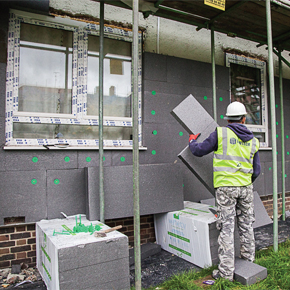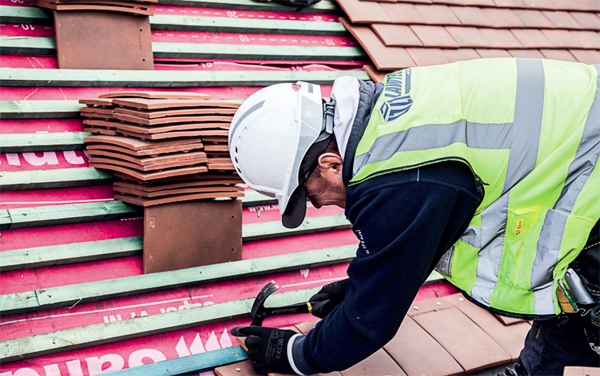
UK housing stock: Refurb or rebuild?
According to David Lawrence, managing director of UK contractor Lawtech Group, the decision to demolish homes is a contentious one, which is why forward thinking and high quality schemes to renovate housing stock are a cost-effective, more environmentally friendly option which can create energy-efficient buildings that are indistinguishable from a new build…
The quality of the home has a significant impact on our health; a warm, dry and secure home contributes to our wellbeing. The problem is that our ageing, inefficient and poor housing is costing the NHS at least £760m1 each year.
While the link between housing and health is perhaps difficult to assess, what is clear is that the need to refurbish our ageing housing stock has become more pressing in recent years considering the increased costs in buying land and developing it.
While demolition and rebuild can be seen by some advocates as a great route to shiny new replacements, particularly in the case of estates that are past saving or left to rot, these newer schemes can increase the density of site development, resulting in smaller room sizes, less amenity space yet higher rents.
Where some people see dilapidated, unhealthy, antisocial buildings that should be knocked down, others see homes, communities and opportunities for renovation and refurbishment.
The thermal performance of a building is one of the most important factors on whether to demolish or refurbish, as it has a big impact on the health of residents and the cost of their energy bills. The refurbishment and retrofitting of buildings though improved insulation, replacement windows and boilers, new heating systems and installing renewable energy can improve the performance of existing buildings to near new standards.
Early engagement
The key to any retrofit is partnership – between landlords, tenants and the contractor. The importance of early engagement between these parties will drive the practicalities of the design and ensure the right retrofit is carried out for a particular estate. A contractor can offer refurbishment expertise and will have a view on whether the retrofit design is possible.
Early considerations are also important with lifecycle costings. What do they want to achieve? What is the end goal and what is the cost-effectiveness of the retrofit?
It is also vitally important to engage with the residents. Proper and effective resident consultation cannot be understated. It is, after all, their homes that are being refurbished. If you engage with them and they like what is being done, then they will be more likely to look after it, when the refurbishment works have been carried out. This will also help with the smooth running of the project. Pilot phases on estates will allow other residents to see what has been achieved prior to roll out.
Improved well-being
While partnering and early engagement is absolutely key to obtaining a good retrofit experience, there are a number of wider benefits of refurbishment. The introduction of higher standards of insulation has a direct impact on the improved health of the occupants. Living in underheated, cold and draughty homes can pose health risks, due to the higher incidences of damp and mould which exacerbate health issues such as asthma, bronchitis and heart and lung disease.

“The refurbishment of our homes and buildings is one of the greatest challenges we face to reducing carbon emissions.”
According to UK Government statistics, 46,700 Britons died prematurely over the last five winters due to living in cold homes. Much of the benefit of improved standards of insulation comes in the form of increased comfort for residents, with the living environment being maintained at higher temperatures. Clearly, investment in energy efficient measures will contribute to reducing the financial strain on the NHS.
The combination of providing energy-efficiency with estate regeneration can also improve the community as a whole. Brighter cladding, improved landscaping and lighting and making an estate more user-friendly will enable residents to take pride in their new look estate and where they live. Furthermore, retrofitting will make residents feel healthier and wealthier, through lower fuel bills, warmer homes and the perception of living in new build or modern homes. A more energy efficient home can also lead to less rent arrears for housing associations and landlords.
Aesthetic improvements
External wall insulation and cladding systems can have a transformative effect on the aesthetics of a building as it provides an opportunity not only to upgrade thermally, but also to improve the look of the building at the same time. The social and health benefits of improving thermal efficiency and improving whole neighbourhoods with a new look cannot be ignored. Cloaking existing constructions with a new skin will have the added benefit of extending the life of the buildings, and work can often be undertaken without disruption to the building’s tenants.
New funding models
While there are a multitude of retrofit programmes being implemented internationally, funding mechanisms in the UK have traditionally been market driven by the Government.
For example, through the Energy Company Obligation (ECO) and ECO2 scheme (which runs until March 2017) the utility business has to get rid of a certain amount of carbon in a certain amount of time but that won’t necessarily fit with the amount of time it takes for estate regeneration.
This finance scheme might be too short a period for an estate to be regenerated. There is now, more than ever, a need for joined up thinking and a need to look at home funding mechanisms which can work with retrofitting estates in the longer term.
The refurbishment of our homes and buildings is one of the greatest challenges we face to reducing carbon emissions. With energy efficiency the cornerstone of estate regeneration, it is imperative that we refurbish a building to last a hundred years and not 20 years and keep re-doing it.
If a structure is sound and in a good enough condition then the most cost-effective plan is to retrofit the building. Refurbishing the existing housing stock will be key to reducing the UK’s carbon emissions so that we can achieve our ambitious targets.
Find out more in the June issue of PSB Magazine
Latest news

8th April 2025
First look at industry speakers for GEO Business 2025
GEO Business, the UK’s premier geospatial event, is set to return to ExCeL London on 4 – 5 June 2025, bringing together the brightest minds in the industry.
Posted in Articles, Building Industry Events, Building Industry News, Building Products & Structures, Building Services, Exhibitions and Conferences, Information Technology, Innovations & New Products, Restoration & Refurbishment, Retrofit & Renovation, Seminars
8th April 2025
Digital Construction Week 2025 announces first wave of industry-leading speakers
Digital Construction Week (DCW), the UK’s premier event for digital innovation in the built environment, is set to return to ExCeL London on 4 – 5 June 2025.
Posted in Articles, BIM, Infrastructure & CAD Software, Building Industry Events, Building Industry News, Building Products & Structures, Building Services, Building Systems, Civil Engineering, Exhibitions and Conferences, Hard Landscaping & Walkways, Health & Safety, Information Technology, Innovations & New Products, Landscaping, Retrofit & Renovation, Seminars
7th April 2025
Abloy UK provides bespoke access control solution for CPA Group’s Lanarkshire HQ
Abloy UK has supplied CPA Group with its PROTEC2 CLIQ solution to streamline access control and protect assets at its headquarters in Shotts, Lanarkshire.
Posted in Access Control & Door Entry Systems, Architectural Ironmongery, Articles, Building Industry News, Building Products & Structures, Building Services, Case Studies, Doors, Facility Management & Building Services, Health & Safety, Restoration & Refurbishment, Retrofit & Renovation, Security and Fire Protection
7th April 2025
ASSA ABLOY EMEIA: A new generation of reader is added to the Aperio digital access family
There is now a way to control access digitally, effectively and wire-free, thanks to ASSA ABLOY EMEIA…
Posted in Access Control & Door Entry Systems, Architectural Ironmongery, Articles, Building Industry News, Building Products & Structures, Building Services, Doors, Facility Management & Building Services, Health & Safety, Information Technology, Innovations & New Products, Posts, Retrofit & Renovation, Security and Fire Protection
 Sign up:
Sign up: